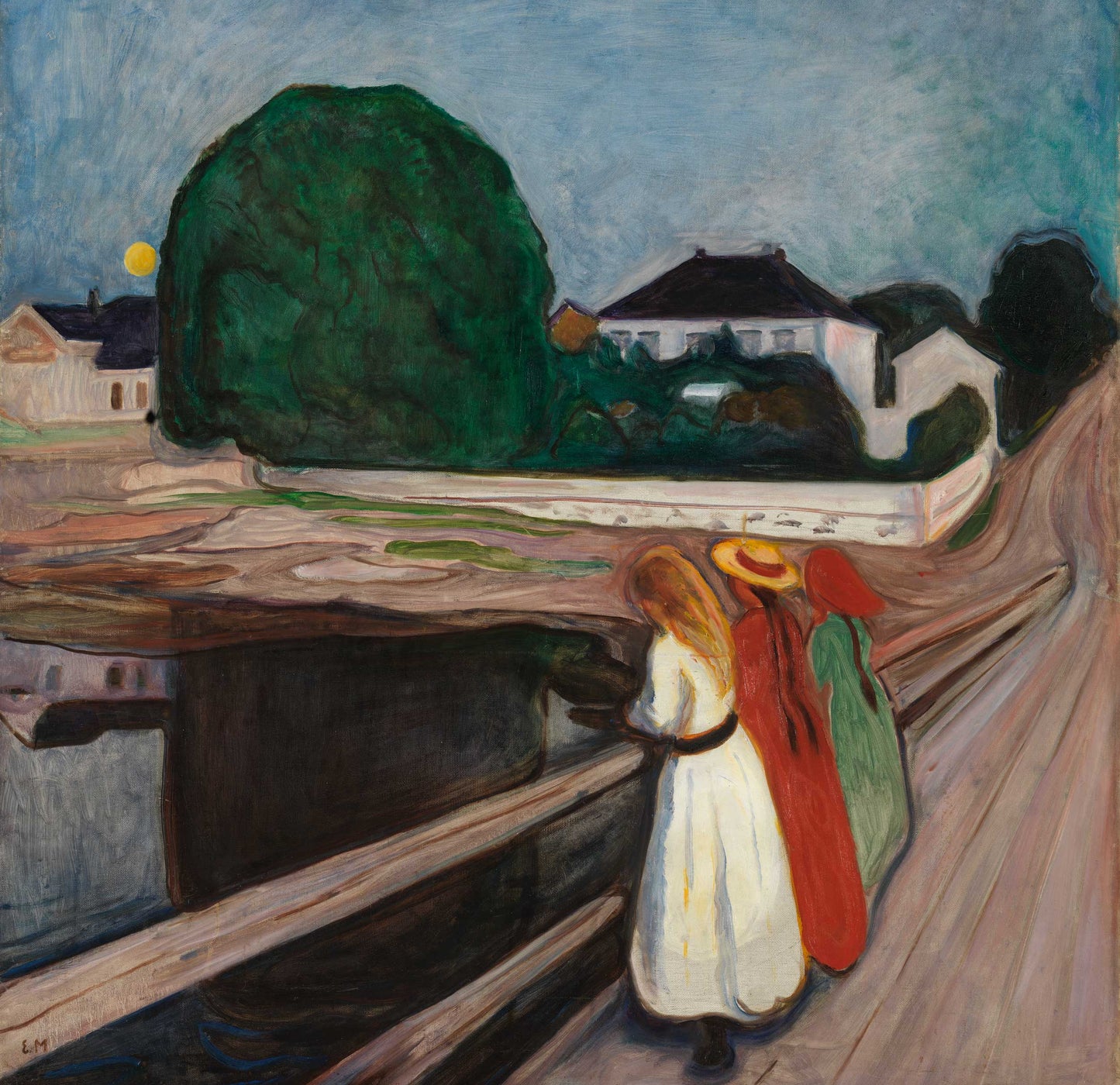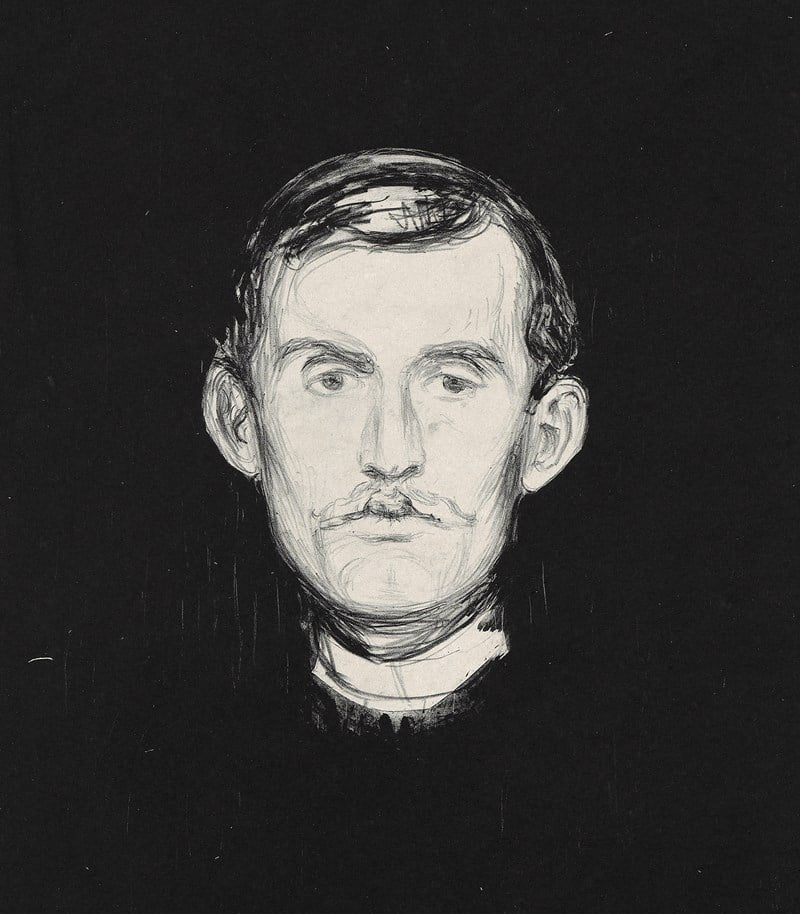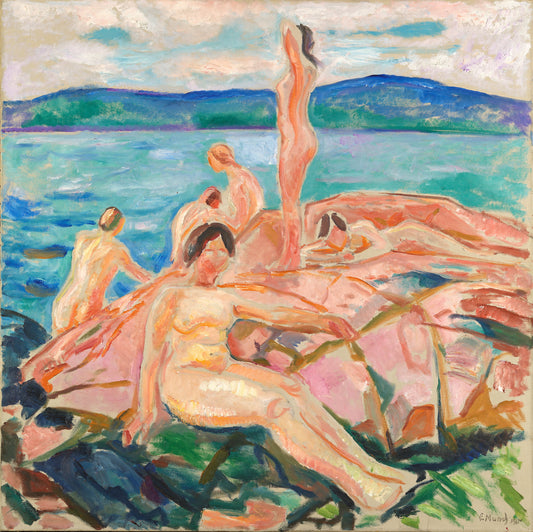Edvard Munch
The girls on the bridge
The girls on the bridge
Couldn't load pickup availability
High-quality reproductions from the National Museum's collection. Posters by DAIDDA are printed on Litho White Matt - 230 gram photo paper in premium quality. Artprints by DAIDDA provide outstanding colors, sharpness and durability in museum quality - printed on Moab Entrada Natural 300 gram cotton art paper. Printed on a matte surface with scratch-resistant pigment ink.
The bright, Nordic summer night inspired Munch. In general, nature is essential in his pictures. The interaction between people and landscape forms a symbolic whole.
Three girls on a bridge with their backs to us. They lean against a railing and look down into the water. The figures, the landscape and the building in the background are painted in a simplified manner, which gives the painting a decorative effect. The girls' dresses are in strong colors and form a contrast to the landscape's pale pink, light blue and muted dark green.
From the bridge we look towards Åsgårdstrand, the coastal town by the Kristianiafjord, where Munch found inspiration for many motifs at this time. In the background we see the stately Kiøsterudgården, which appears again in several of his pictures, as well as a huge, dark green tree. The full moon hangs low and can be seen on the horizon behind the tree. The railings on the bridge and the winding road create an attraction into the landscape. This is a compositional move we recognize from, among other things Rue Lafayette (1891) and Scream (1893). Reusing certain elements from his own pictures and putting them into new contexts is consistent in Munch's artistry.
The picture has had different titles and was first shown at an exhibition in Kristiania in 1901 with the title Summer evening . It was also included in Munch's exhibition in Berlin Secession in 1902. Then it had the title Norwegian Sommernacht . With its monumental form, simplification and use of colour, the motif has a closeness to Life's dance. But in terms of content, the two images are different. The dance of life has a symbolic love theme, while The girls on the bridge shows three children and is to a lesser extent narrative and action-oriented.
In the following years, Munch showed in his paintings an interest in portraying childhood and the child's view of the world. In 1898 he bought a small house in Åsgårdstrand, where he enjoyed himself. Through the house purchase, he gained a stronger connection to the local environment and got the permanent residents to pose as models, such as in The girls on the bridge . He later commented on the place like this: "Walking here is like walking among my pictures. I get such an urge to paint when I walk in Åsgårdstrand".[1] Munch painted several versions of the motif as well as a variation with young women on the bridge. The National Museum's painting is the first in the series.
Shipping and returns
Shipping and returns
Shipping: We deliver to Scandinavia, the EU, the USA and several other countries. Please contact us if your country is not listed and we will try to arrange delivery.
Delivery time: 2-5 days within Norway, 7 days in Europe, 14 days globally.
Packaging: Our products are made to order and sent rolled in environmentally friendly packaging.
Customs Fees: International orders may be subject to customs fees, which are not included in shipping costs.
Return policy: You can return images within 14 days. See our returns page for more information.
Secure Payment: We never store your payment details. See our privacy policy for details.

See all works
-
Bathing man
Vendor:Edvard MunchRegular price From 150,00 NOKRegular priceUnit price per -
High summer
Vendor:Edvard MunchRegular price From 150,00 NOKRegular priceUnit price per -
Flower meadow at Veierland
Vendor:Edvard MunchRegular price From 150,00 NOKRegular priceUnit price per -
Rue Lafayette
Vendor:Edvard MunchRegular price From 150,00 NOKRegular priceUnit price per

Edvard Munch
Edvard Munch worked as an artist for over sixty years. He was creative, ambitious and hardworking. He made close to two thousand paintings, hundreds of graphic motifs and thousands of drawings. In addition, he wrote poems, prose and diaries. Scream, Madonna, Death in the sick room and the other symbolist images from the 1890s have made him one of the most famous artists of our time.
"Don't become an artist!" Edvard wanted to become an artist early on, and there was no doubt that he had talent. But his father refused to allow him to follow his dream, and Edvard therefore began studying to become an engineer. But after just one year, he chose to defy his father, and changed the engineering school to the Royal School of Design in Kristiania. Talented and provocative bohemian It was obvious to everyone in the Norwegian art community that the young man was a rare talent. In 1883, aged 20, he made his debut at the Autumn Exhibition. In 1886, Munch became acquainted with the writer and anarchist Hans Jæger, the leader of Kristiania-bohemen. The bohemian milieu convinced Munch that art had to renew itself in order to reach people, and to mean something in their lives. In the same year, he exhibited the painting The Sick Child. It created debate! Courage led to a breakthrough. Some said that The Sick Child was brilliant, while others thought it was unfinished and that it had nothing to do at an exhibition. Today this is considered Munch's breakthrough. Here he showed independence and a willingness to take new paths.
With one key word, we can say that his artistry from here until his last brush stroke is characterized by experimentation. Munch did not care about established "rules" for so-called good art. His techniques in both painting and graphics were innovative. From man's emotional life, to agriculture and landscape Henrik Ibsen's dramas about man's existential challenges inspired Munch. Themes such as death, love, sexuality, jealousy and anxiety were central to his early pictures. Some themes sprung from personal experiences. For example, Death in a hospital room and The sick child can be linked to his recollection of his mother's and sister's illness and early death. After 1910, Munch chose a quieter and more withdrawn life. With his own farm both at Ekely and in Hvitsten, he found completely new motifs, such as agriculture, working life and landscape. The man in the cabbage field is a typical example from this time.





